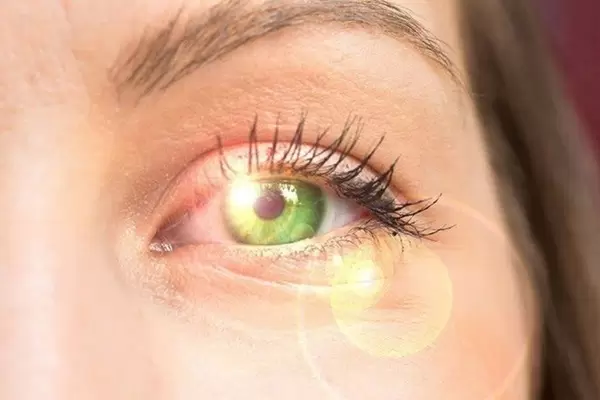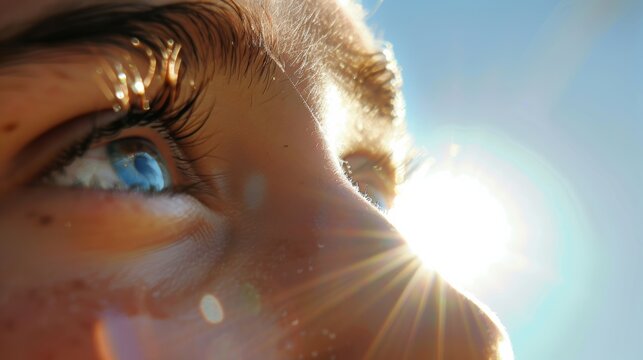Pterygium, also referred to as ‘surfer’s eye’, is a benign condition that may affect the eyes. It appears as a reddish or pinkish growth on the sclera and requires special care. Usually, it begins from the inner canthus of the eye and with time can extend towards the center. While not considered dangerous, its negligence may result in discomfort and hindrance to sight.
Let us explore the treatment options and look at how this condition is influenced by sunlight.
What is Pterygium?
 Pterygium results from non-cancerous growth of the soft tissues surrounding the eye. It almost always begins at the sclera closest to the nose and spreads towards the cornea. This ailment can occur in one eye or both.
Pterygium results from non-cancerous growth of the soft tissues surrounding the eye. It almost always begins at the sclera closest to the nose and spreads towards the cornea. This ailment can occur in one eye or both.
Pterygium appears to be an elevated wedge-shaped section. Often, it remains small, but there are cases in which it has grown large enough to reduce vision. People who spend much time outdoors tend to get this more, indicating that it is more common in adults.
Is Sun Exposure a Major Cause?
Sunlight remains the most frequent pterygium causes. People spending time outdoors without UV sunglasses are the greatest risk group.
The surface of the eyes can be damaged from the sun emitting ultraviolet rays (UV rays) by exposing the eyes to ultraviolet light for long durations of time. The overgrowth of tissue that may occur owing to this Pterygium condition is indeed harmful.
That is the reason why it is referred to ‘surfer’s eyes’ since it is widely seen with outdoors active people.
Other Common Pterygium causes
Sun exposure is a very important factor. However, several other things can lead to Pterygium as well:
- Dust and wind: Continuous exposure to dry, dusty, or windy environments can irritate the eyes.
- Autoimmune disease: People with dry eyes may develop Pterygium with ease.
- Pollution: Smoke, air pollution, or other irritants can cause changes to the eye’s surface.
- Family history: If you have a family history of Pterygium, do not be surprised if you have one, too.
Understanding all of the pterygium causes can help you greatly in taking care of your eyes.
What Are the Symptoms of Pterygium?
A pterygium patient may show some symptoms based on how severe and how large the pterygium is. These are the most common symptoms that are noted:
- Pink Eye
- Foreign body sensation
- Itching
- Dry eyes
- Blurry vision in more severe conditions
If any of the above symptoms are experienced, it is very important to book an appointment with an eye doctor as soon as possible.
Can Pterygium Get Worse?
Absolutely. Without treatment it can get larger and bring about further desafíos. In addition to changing the shape of the eyeball and causing blurred vision, large pterygia [growths on the conjunctiva] may restrict one’s eyesight.
While treatment may be given, recurrent occurrences of Pterygium may happen in some cases. That is why effective treatment along with preventive measures is vital.
How Is Pterygium Diagnosed?
Just a general eye exam is sufficient. The eye specialist will examine the anterior segment of the eye with a slit lamp, which provides a good view of the lesion.
No special tests are usually required. However, if the physician thinks there is a possibility of underlying problems, other investigations may be proposed.
How to Prevent Pterygium?
An old saying states that, ‘To prevent is better than taking action post the fact’. With this in mind, here are some tips to help reduce the likelihood of developing eye issues:
- Wear sunglasses: Prescription eyewear should be chosen based on the fact that a patient’s sunglasses should unequivocally block a person’s view of the sun’s rays.
- Use protective eyewear: Patients should wear protective goggles in dusty or windy areas of work.
- Keep your eyes moist: Use lubricating eye drops if the patient has dry eyes.
- Avoid smoke and pollution: Spend less time in harmful environments.
The above recommendations will assist in avoiding one of the key factors to the risk of pterygium: the exposure to dry environments and the sun.
Conclusion
Pterygium is an eye condition found in many individuals, yet it can be treated effectively. For outdoor enthusiasts, sunlight is one of the primary causes. Additional causes such as dust, pollution, and weather may also contribute to the condition. The silver lining is that proper treatment will completely manage the problem.
Those experiencing eye irritation such as redness, blurriness, or even a bump should seek medical attention immediately.
At Dr. Jawahar Lal Rohatgi Smarak Netra Chikitsalaya, we provide advanced care very close to home. One of the many services offered is the treatment of Pterygium and other eye conditions through the use of Pterygium equipment. Our specialists ensure high-quality results, whether routine care or specialized surgery is needed.





 Call Us Now
Call Us Now
Leave a Reply